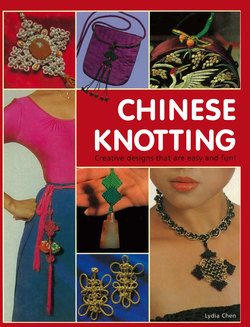Читать книгу Chinese Knotting - Lydia Chen - Страница 7
На сайте Литреса книга снята с продажи.
ОглавлениеAUTHOR’S FOREWORD
When I was young, writing a book on traditional Chinese decorative knotting was as inconceivable to me as time travel is now. I was too busy climbing trees and playing ball to sit still long enough to tie my shoelaces, let alone a decorative knot.
Even while I was in college, sports continued to occupy most of my thoughts, with perhaps some time spared for my major in agricultural chemistry. No matter how you look at it, both my curricular and extracurricular activities were just about as far afield from folk arts as I could get.
An unexpected twist of events, however, changed the course of my life. It started about ten years ago when Wang Chen-kai, a master knotter from Mainland China, began working at the National Palace Museum in Taipei. My late father-in-law, Chuang Shang-yen, who was Deputy Curator at the Museum, urged me to learn whatever I could from Wang. I did not think that anything would come from it. Still, I had a bit of free time and I thought the knots were attractive, so I began tying my first knots.
Soon I was trying my hand at tying more and more difficult knots, and I found my interest growing. I was thrilled when I learned that ECHO Magazine was doing a series of articles on Chinese knotting in 1976. I bought the issues and practiced tying the 13 simple knots taught in the magazine until I could tie each and every one of them with my eyes closed. From that point on, I was determined to learn everything I could about this ancient art.
In 1978, I received a surprise call from Chang Ching-shih, the dean of Shih Chien College of Home Economics. He had decided to start a course in Chinese knotting, and wanted me to teach the class. Although I was just a novice knotter then, Dean Chang had no one else to turn to. He flattered, chided, and cajoled me, and somehow, against my better instincts, I agreed to take on the task.
Luckily for me there were still three months to go before the fall semester began. I spent that time practicing my knots day and night. I tracked down antiques with knots I had never seen before, and then spent hours trying to figure out how each of them had been tied. I created a few knots of my own, and experimented with a wide variety of cords. Then in September, with knots in my stomach as well as in my hands, I walked into my first class.
Knotting was an idea whose time had come again. The next fall my teaching load at Shih Chien tripled, and people from all walks of life — jewelers, clothiers, students, housewives, even businessmen — were asking me for private lessons.
It was heartwarming to see such fresh interest in this old folk art tradition. But not everyone has the time or the inclination to enroll in a home economics college, nor could I take on the entire populace as private students. And except for the ECHO Magazine articles, there was no literature on the subject. I thought the time had come to put out a comprehensive instruction manual on the art of Chinese decorative knotting.
Of course, I had neither the experience nor the wherewithal to publish a book on my own. I knew how to tie the knots and how to teach others to tie them, but I knew little about writing, editing, photography, layout, or financing the publication of such a book. ECHO came to my aid again. They said that if I would put together the material, they would handle all the editorial and technical work involved in publishing an English as well as a Chinese edition. By doing so, they have not only earned my gratitude, but the gratitude of everyone who wants to learn Chinese knotting or see the tradition regain its hold on life.
I hope that you will find our effort both informative and practical. If even a handful of people can use this book to find some of the pleasure that knotting has given me, I will be more than satisfied. As I would express it in Chinese, I will feel I have given a brick in exchange for a piece of fine jade.
January, 1981
